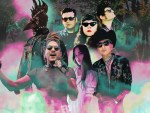The Mess is a new column from journalist Richard Villegas, who has been reporting on new, exciting sounds flourishing in the Latin American underground for nearly a decade. As the host of the Songmess Podcast, his travels have intersected with fresh sounds, scene legends, ancestral traditions, and the socio-political contexts that influence your favorite artists. The Mess is about new trends and problematic faves whilst asking hard questions and shaking the table.
We’re going there. We’re talking about it. Even if things get a little messy.
Back in October 2023, the world was introduced to a new generation-defining anthem called “Como El Perro Bebe Agua,” a blazing merengue típico performed by Dominican singer and accordionist Nelly Swing, aka La Rompe Ola. With its thinly veiled allusions to cunnilingus and uproarious gobbling singalongs, the song went ultra viral and dominated subsequent holiday parties across the island and the diaspora. But perhaps most interesting was how the song echoed a growing dialogue between sacred merengue and bachata traditions and the swaggy flows of rap and dembow.
“Como El Perro Bebe Agua” is officially credited to bachata singer and composer Andy Peña, who also penned “El Burro Mañoso,” with its iconic braying chorus, and the campy yet poignant gay liberation anthem “Quiero Volar.” But the aforementioned thirsty dogs popped up two years prior on a dembow track of the same name, chorus, and lascivious intention. About two weeks after Nelly Swing’s leap to fame, a troop of content creators called NOVELPOPPYS reimagined the song as “El Mono Come Guineo,” conceiving a phallocentric counterpart to the original. They’ve also trended with merengue covers of numerous dembow hits, including Rochy RD’s “Que La Choke” and Jey One’s “Cintureo.” But as this musical intersection grows increasingly crowded, free-flowing influence is also rejuvenating sounds and scenes that were once erroneously understood as diametrically opposed.

“Merengue típico has never lost its essence, but young people always bring new ideas,” says rapper Inka, whose 2023 debut album Villa Mella boldly wove dembow and reggaeton with son and palo. “You can actually hear the influence of merengue on dembow, sometimes deliberately and others subconsciously, simply because it’s in our DNA. The chorus for ‘Se Puede Repetí’ by Mestizo Is Back keeps a particular time and phrasing that could easily fit merengue. And on Yaisel LM’s “Boy Boy” or Donaty’s ‘Eso E,’ the drums sound like pambiche. Even the repetition of syllables in dembow is homologous to merengue’s bass and horn rhythms.”
In fact, merengue típico is on a massive come-up. Once synonymous with the Cibaeño countryside and accordion-armed legends like Fefita La Grande and El Prodigio, the propulsive folk genre got another X-rated boost last year when La Inquieta Típica covered Colombian vallenato group Rastrojo’s “Mamá Cela.” Then there’s the emergence of El Rubio Acordeón, who broke through with his version of José Muñoz’s cumbia classic “El Abogado (Mariela),” followed by major collaborations with Ozuna on “La Propuesta” and dembow godfather Chimbala on “10 Muchacho.” The songs also incorporate electronic beats and send frequent shout-outs to the street, underscoring the evolution of tradition as new generations take over.
“Everything is cyclical,” adds Max Cueto, co-founder and editor of the essential Dominican music blog Discolai. “In their respective beginnings, both bachata and perico ripiao were marginalized genres. And even though today bachata has achieved global status, dembow is reaching for those same heights of popularity. All these genres use double entendre, which highlights more songwriting commonalities than differences and has driven young people back into this sort of roots music. Mind you, bachata is also música urbana — it was born in los barrios.”

You can actually hear the influence of merengue on dembow, sometimes deliberately and others subconsciously, simply because it’s in our DNA… Even the repetition of syllables in dembow is homologous to merengue’s bass and horn rhythms.
Where merengue típico has remained evergreen across Quisqueya, bachata’s biggest exponents of the new millennium overwhelmingly come from the U.S. Prince Royce, Aventura, and later Romeo Santos as a solo artist, became proud beacons of The Bronx’s Dominican diaspora, later preaching the lovelorn gospel of bachata around the world. Meanwhile, artists on the island have been melding the rum-soaked colmadón confessions of Blas Durán and Luis Segura with dembow codes pouring out of the incandescent neighborhood, 42 de Capotillo.
Sandpaper-voiced dembowsero El Napo is currently metamorphosing into a street dandy clad in retro drip and wailing dramatically about heartbreak. A decade earlier, genre-adventurous rapper Vakeró tapped bachata icon Anthony Santos for “Hoy Se Va Beber,” later receiving an invitation to salute the “Voy Pa ‘Llá” singer in a sprawling tribute at Santo Domingo’s Premios Soberano. Vakeró is a cornerstone of the bachata/dembow crossover wave, and last year, he brought another eminence, Luis Vargas, into La 42 to record more heat.
Perhaps the most exciting new school project dancing on these genre lines is Los Sufridos. The mysterious supergroup consists of rapper T.Y.S., jazz-merengue guitarist Mitiko of La Gran Mawon, and superstar dembow producer Cromo X – whom you might remember from his fire collaboration with C. Tangana. Los Sufridos are staying true to bachata’s street-savvy roots, pairing melancholy guitars with throbbing digital beats and enlisting buzzy dembowseros like Kiko El Crazy and La Mas Doll to guest on tracks and highly stylized music videos.

“Bachata has maintained its edge because artists remain interested in reaching younger audiences,” reflects Inka. “At an aesthetic level, bachateros have been savvier on social media. They dress fresh, kind of in the urbano flow. Elvis Martinez, El Chaval de la Bachata, Eudis El Invencible; they’ve all understood the power of virality and staying relevant.”
Make no mistake, reaching across the genre aisle has also stirred controversy. For many nostalgic fans, memories of dancing to bachata and merengue at weddings and birthday parties are at odds with the vulgar lyrics of dembow, conveniently forgetting how these foundational songs were once maligned for provocative lyrical content. Not all artists have let genre prejudice rule their judgment, as even modern merengue architects Los Hermanos Rosario performed alongside Dominican rap trailblazer Lapiz Conciente. In 2018, Fefita La Grande made headlines after shaking her behind all over Santiago’s El Monumento for El Mayor Clásico’s “Ven Meneate” Remix. And in 2021, fusion queen and influential indie matriarch Xiomara Fortuna enlisted Vakeró and Farruko-producer Ghetto for her exuberant LP Viendoaver, gleefully colliding jazz, merengue, dembow, and trap.
More than anything, we need to break with the stifling urge to box artists into neat genre categories. In 2019, Kiko el Crazy and a bunch of other dembowseros fashioned themselves as merengue idols to pay homage to Milly Quezada, part of a joyful and widely publicized Christmas campaign. And even Tokischa’s polarizing turn on NPR’s Tiny Desk received praise for the robust merengue grooves of her backing band. The point is that curiosity and artistic expression are unbound by genre. All these artists are clearly paying attention and learning from each other, so instead of dreaming up moralist rivalries, just dance. That’s all anyone is asking.





